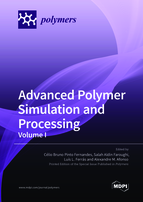Advanced Polymer Simulation and Processing
A special issue of Polymers (ISSN 2073-4360). This special issue belongs to the section "Polymer Processing and Engineering".
Deadline for manuscript submissions: closed (18 December 2022) | Viewed by 125785
Special Issue Editors
Interests: rheology; swelling; viscosity and viscoelasticity; polymers at interfaces and in confined spaces; numerical simulation; constitutive and multiscale modeling
Special Issues, Collections and Topics in MDPI journals
Interests: Machine Learning & Big Data Analytics; Renewable & Clean Energy Resources; Carbon Capture and Storage Systems; Dynamics of Viscoelastic and Energy Materials; Computational Physics and Numerical Modeling
Interests: numerical analysis; integro-differential equations; mathematical modelling; viscoelastic flows; anomalous diffusion; machine learning
Special Issues, Collections and Topics in MDPI journals
Interests: theoretical and computational rheology; complex flows of complex fluids; electrokinetics; multiphase flow; micro-combustion
Special Issues, Collections and Topics in MDPI journals
Special Issue Information
Dear Colleagues,
Polymer-processing techniques are of utmost importance for producing polymeric parts. The main concern is to produce parts with the desired quality, which is usually related to the mechanical performance, dimensional conformity, and appearance. Aiming to maximize the overall efficiency of the polymer-processing techniques, advanced modelling codes along with experimental measurements are needed to simulate and optimize the processes.
Thus, this Special Issue will welcome contributions which exploit the digital transformation of the plastics industry, both through the creation of more robust and accurate modelling tools and cutting-edge experimental techniques. Furthermore, contributions on advanced topics, such as crystallization during the solidification processes, prediction of fiber orientation in the cases of short and long fiber composites, prediction of the foaming process (such as microcellular foaming), and flow instabilities by the inclusion of viscoelastic constitutive equations are welcomed.
Dr. Célio Fernandes
Dr. Salah Aldin Faroughi
Pro. Dr. Luís Lima Ferrás
Pro. Dr. Alexandre M. Afonso
Guest Editors
Manuscript Submission Information
Manuscripts should be submitted online at www.mdpi.com by registering and logging in to this website. Once you are registered, click here to go to the submission form. Manuscripts can be submitted until the deadline. All submissions that pass pre-check are peer-reviewed. Accepted papers will be published continuously in the journal (as soon as accepted) and will be listed together on the special issue website. Research articles, review articles as well as short communications are invited. For planned papers, a title and short abstract (about 100 words) can be sent to the Editorial Office for announcement on this website.
Submitted manuscripts should not have been published previously, nor be under consideration for publication elsewhere (except conference proceedings papers). All manuscripts are thoroughly refereed through a single-blind peer-review process. A guide for authors and other relevant information for submission of manuscripts is available on the Instructions for Authors page. Polymers is an international peer-reviewed open access semimonthly journal published by MDPI.
Please visit the Instructions for Authors page before submitting a manuscript. The Article Processing Charge (APC) for publication in this open access journal is 2700 CHF (Swiss Francs). Submitted papers should be well formatted and use good English. Authors may use MDPI's English editing service prior to publication or during author revisions.
Keywords
- Numerical simulation
- Multiscale modeling of polymeric systems
- Artificial intelligence
- Machine learning
- Extrusion
- Injection molding
- Blow molding
- Plastic foam molding
- Viscoelasticity










